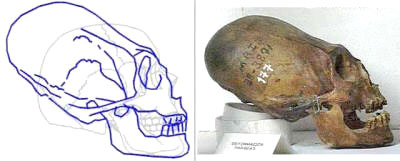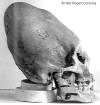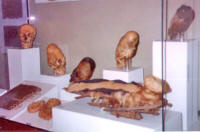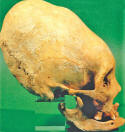|
These skulls were photographed by Robert Connolly on his trip
around the world during which he was collecting materials about
ancient civilizations. The discovery of unusual skulls was thus an
unintended "spinoff" of his efforts. Robert Connolly
published his photographs on a CD-ROM, titled "The Search For
Ancient Wisdom", Cambrix, 1-800-992-8781, in 1995.
The data about the skulls is incomplete, and that makes the correct
assessment of their age, context with other hominids, as well as
placement of their origin extremely difficult. Some of the skulls
are very distinct, as if they belong to entirely different species,
remotely similar to genus Homo. The first thing that attracts
attention is the size and shape of the cranium in all the specimens.
There are 4 different groups represented in the pictures. As a
matter of convenience, I labeled them "cone-head", "jack-o-lantern"
or "J" and "M" based on the shape of the
skull, except the first and possibly earliest type of skull, which I
call "premodern".
When some of these pictures (the first two) were posted on CompuServe
more than year ago, the majority of people assumed that they
represented an example of binding of the head, well known to be in
fashion in ancient Nubia, Egypt and other cultures.
The problem with this theory is that the inside of the cranium of
the mentioned skulls, although elongated and with a back sloping,
flattened forehead, have the same capacity as normal human skulls;
the only difference is the shape achieved by frontal
and side deformations. They are actually more similar to the first
type of skull (premodern) with the rounded back, than
the cone-head type. The cone-shaped types of skull are
not found amongst the usual skull-binding samples.
The first skull presents problems of its own. The frontal part of the
skull seems to belong to an individual of the pre-Neanderthal
family, but the lower jaw, though more robust than modern human
type, has a modern shape and characteristics. The shape of the
cranium does not have any comparison with the Erectus, Neanderthal
types, nor the modern human type. Some minor Neanderthal
characteristics are present, as is the occipital ridge on the bottom
back of the skull and the flattened bottom of the cranium, other
characteristics point more towards Homo Erectus. The angle of the
cranial bottom is, though, unusual. We cannot exclude the
possibility of a deformed individual in this case, but it is highly
unlikely that the angle of the frontal part would require a
modification of the lower jaw in the process of growing to
resemble modern human types with their projected chin rim.
The answer seems to be that the skull belongs to a representative of
an unknown premodern human or humanoid type.
As is obvious from the comparison with a modern human skull, the
cranial capacity lies within the modern human range. This is not
surprising, since the late Neanderthals and early modern humans
(Cro-Magnon) had larger cranial capacities (both roughly 1600 cm3
to 1750 cm3) than modern humans (av. 1450 cm3).
The decrease of the cranial capacity (sudden at that -- the
specimens of modern humans after about 10500 BCE have smaller
craniums) is a puzzling matter, but that's another
story.
No less puzzling is what a representative of a premodern human
type is doing on the South American continent. According to the
orthodox anthropology, this skull simply does not
exist, because it cannot be. Textbooks' oldest date of
appearance of humans in North America is about 35000 BC and much
later for South America, based on the diffusion theory
assumptions. The only accepted human types entering the
continent are of the modern anatomy. There are some other sources
that place all types of human genus in both Americas at much earlier
dates based on numerous anomalous finds, but the academe
sticks to its preconceived notions, no matter what. It's
safer.
|

Premodern |
The "premodern"
skull
and the following three specimens were found in the
Paracas region of Peru. It does not necessarily mean that
they are related. There is some possibility that the "premodern"
is in fact a precursor of the "cone-head" type, but since we do not
have any dating analysis at hand, we may only speculate in this
regard.
|

Figure C1 |
The "cone-head"
type is very unusual because of the cranial shape. Here we have
three specimens, which exclude the possibility of random or
artificial deformation (the already mentioned Nubian deformations
had quite a number of individual variations). They have individual
characteristics within the range of overall morphology. There is no
doubt that they are closely related and possibly represent quite a
distinct branch of the genus Homo,
if not an entirely different species.
|

Figure C2 |
|

Figure C3 |
The comparison of the
C1 with a modern human skull has slight inaccuracies,
caused by a degree of distortion when rotating the skull shape into
position. As is obvious from C2 and C3,
the angle of the bottom part of the cranium does not deviate from
normal. However, the general proportions are correct.
The enormity of the cranial vault is obvious from all three pictures.
By interpolation, we can estimate the minimum cranial capacity at
2200 cm3, but the value can be as high as 2500 cm3.
The shape of the skull may
be a biological response - a survival of the species mechanism - to
increase the brain mass without the danger of relegating the species
to extinction and keeping a viable biological reproduction intact.
However, since we do not see the representatives of the "cone-head"
type in modern population, something prevented the type becoming
as widespread as it is in the case of present-day moderns.
|

Type "J" |
The "J" type
of skull presents different sets of problems. It is an equivalent of
the modern type of skull in all respects, with only several factors
out of proportion. Less significant is the size of eye sockets which
are about 15% larger than in modern populations. More significant is
the enormity of the cranial vault. The estimated cranial
capacity ranges between minimum of 2600 cm3 to 3200 cm3.
|

Type "M" |
Again, the age of the
specimen is unknown and so far I am not aware of other specimens of
this type. The variation on a theme may be the "M"
type of skull which is even more bizarre than all the previous
skulls.
The "M" type
of skull is incomplete, as the lower part of the facial area is
concerned. What is apparent from the remnants of the facial portion
is that the characteristics are entirely within the range of a
normal human skull. The cranial vault, on the other hand, is the
largest amongst the displayed specimens. Also, the two protruding "lobes"
are highly anomalous. The cranial capacity can be estimated
safely above 3000 cm3 mark.
Both "J" and
"M" types are bordering on biological impossibility.
The only explanation I can imagine for the specimens to be naturally
born is if the neoteny (the ability of the species to
prolong the growth period before maturing) of both groups had been
expanded beyond the range for a modern type of human, for the skull
to grow to such a size. That may also mean the average life span of
these specimens may have been substantially longer than the average
for the modern human type.
Any conjectures that what these specimens represent are simply
deformations or pathological cases can be hardly substantiated.
Anomalous types of growth or shapes appear from time to time in the
modern human population, however, these occurrences are still within
the range of the given species. The largest skull documented in the
medical literature had the cranial capacity of 1980 cm3,
however,
the shape of the skull was normal. Also, it is necessary to
keep in mind that any pathological growth of the cranium has dire
consequences for the afflicted individual at the early stage of the
development, practically without exception. Nature is very
unforgiving in this respect. All the specimens presented here were
mature individuals.
The capacity of the cranial vault (and thus the brain mass)
and intelligence is not necessarily indicated by the other. The
individual with the largest skull, already mentioned above, was a
retarded man, while Anatole France with his 1100 cm3
was quite a brilliant writer.
More "alien" Skulls
  

|






